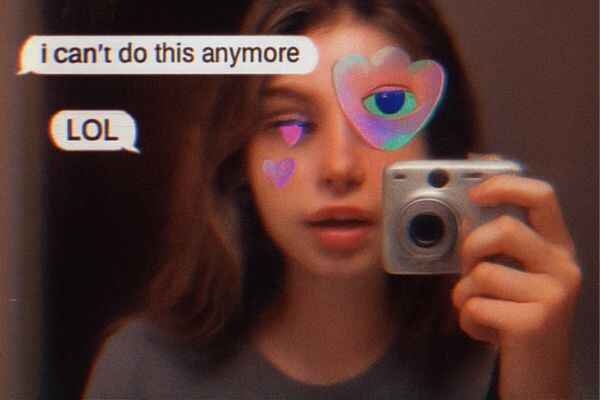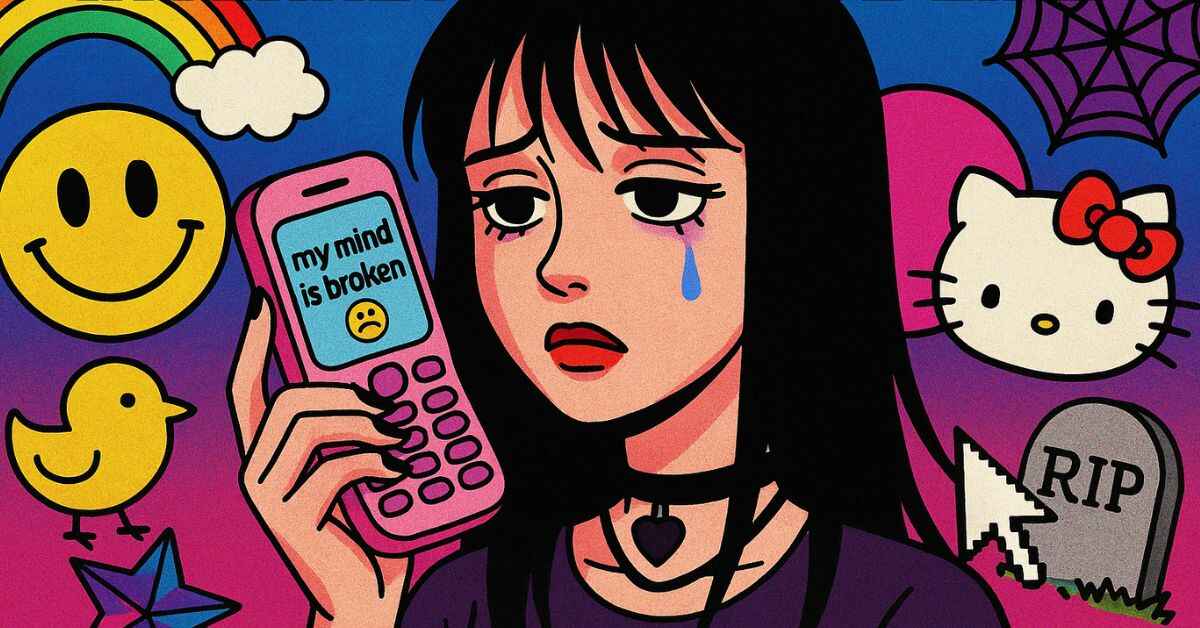1. What Are “Internet Chicks” in 2025?
In 2025, the term “Internet Chicks” isn’t just slang—it’s shorthand for a full-blown digital phenomenon. It represents a new wave of hyper-aware, culturally fluent young women who command attention across platforms through their unfiltered, ironic, and emotionally complex digital presence. These girls aren’t trying to chase algorithms—they’re manipulating them.
From TikTok edits to Discord confession threads, they wield online spaces like art forms. Their style? Somewhere between horror-core aesthetics, chaotic memes, and a neon-drenched diary. A single grainy selfie captioned with “this is what digital burnout looks like” might spark a weeklong trend. And their fashion? Thrifted mall goth, blurry filters, 2000s flip phones—half cosplay, half protest.
What sets them apart isn’t polish—it’s precision. Their content feels haunted and hilarious, meta yet deeply vulnerable. This isn’t influencer culture. It’s a decentralized performance of identity that’s raw, rhythmic, and endlessly remixable.
“She trauma dumps in Comic Sans over a photo of a haunted Chuck E. Cheese,” joked one viral TikTok—perfectly capturing the tone of today’s Internet Chick.
2. From Aesthetic to Archetype: The Evolution of Internet Girl Tropes
Rewind to the Tumblr era, and “internet girls” were pastel dreamers in flower crowns quoting Sylvia Plath. But by 2025, that image has pixelated and split into dozens of digital archetypes—each one acting as a fragmented mirror of online femininity in chaos.
Here are a few standout personas that define this new era:
- The Digital Hollowgirl
Obsessively archives analog horror edits, wears lip gloss over smudged eyeliner, and posts mirror selfies glitched to the point of abstraction. - The Meme Oracle
A digital trend prophet—she breaks down nostalgia cycles while photoshopping SpongeBob into Y2K rave flyers. - The Feral Poster
Lives in comment sections and reply chains, weaponizing cursed memes and emotional oversharing as social critique. - The Sadcore Slay Queen
Mournfully glamorous—think slowed-down hyperpop, tears with sparkle filters, and captions like “crying in low bandwidth.”
These aren’t just aesthetics—they’re methods of survival. They allow digital natives to process trauma, identity, and alienation with layered humor and surreal visuals. Even a single pixelated Hello Kitty with laser eyes can become a manifesto.
Each archetype acts as an internet diary entry, fragmented but intentional—turning scrolling into a ritual of self-exploration, not just distraction.
3. Meme-First Mentality: How Humor Powers Their Influence
Internet Chicks in 2025 aren’t playing the social media game the old-fashioned way. They’ve made memes their medium—and their message. Unlike polished influencers who rely on branding kits and aesthetics, these girls cultivate intimacy through absurdist, glitchy, meme-first communication.
The humor? It’s cryptic, dark, and sometimes uncomfortably honest. A TikTok might open with a how-to style intro before devolving into a meltdown over digital loneliness—scored by distorted baby sounds or clowncore beats.
This isn’t just comedy—it’s catharsis.
Blurry raccoon pics, AI-generated Garfield horror edits, stitched audio mashups—these are tools, not gags. Internet Chicks post like they’re inside a group chat with the entire internet, decoding shared anxieties with pixelated punchlines.
And unlike earlier Gen Z meme styles, which celebrated absurdity for its own sake, today’s humor carries emotional undertones. Irony here isn’t a shield—it’s a scalpel. A chaotic image might make you laugh, then pause, then feel seen.
They aren’t following trends—they’re rewriting the language of memes in real time. Their humor disrupts, disorients, and ultimately connects, forging digital kinship from the noise.

4. Platforms That Birthed Them
The rise of Internet Chicks isn’t thanks to one platform—it’s the result of a chaotic ecosystem of apps, each contributing to the puzzle. TikTok, Instagram, BeReal, and Discord all played crucial roles—but not how you’d expect.
- TikTok gave them speed. Its fast loops allowed for micro-stories and meme-jumpscares packed into 15-second bursts. The algorithm didn’t just reward creativity—it demanded experimentation.
- Instagram gave them irony. The app’s decline into aesthetic fatigue became fertile ground for anti-influencer content. Grainy front-camera shots paired with surreal or ironic commentary began to outperform traditional influencer aesthetics.
- BeReal gave them irony-as-performance. Built to encourage spontaneity, it quickly morphed into a platform where odd, eerily staged “realness” was more telling than any curated post.
- Discord gave them space. Away from public feeds, invite-only servers became incubators for emotional venting, niche memes, and experimental identity crafting.
But the real birthplace of Internet Chicks? The tension between self-expression and self-surveillance. While the mainstream internet pushed authenticity as a product, these girls turned it into performance art.
They toy with the illusion of realness, making every post feel like both a diary entry and a digital stunt. This push-pull—between self and stage—is where their power truly lives.
5. From Glitchcore to Hollowcore: The Visual Language
The visual identity of Internet Chicks is not just a trend—it’s a coded emotional language. In 2025, their aesthetics are haunted by the digital echoes of glitchcore, cursedcore, hollowcore, and lo-fi grunge. Every filtered selfie, AI-generated sketch, or distorted Hello Kitty meme is a mood board of millennial angst and Gen Z disillusionment.
Glitchcore is the language of digital chaos—blurry, broken, and defiant. It’s not about being pretty; it’s about being seen through a cracked screen. These girls wear the visual decay like armor: pixelated video filters, VHS static, and corrupted visuals symbolize emotional fragmentation. Aesthetic imperfection becomes a mirror to inner glitching.
Hollowcore, on the other hand, is softer but more unsettling. It’s the aesthetic of emotional vacancy—empty school halls, liminal spaces, and washed-out tones that evoke late-night scrolling sadness. Internet Chicks channel this vibe to articulate feelings of existential detachment in a post-authentic internet.
Cursedcore brings the surreal. Think: melting animations, creepy filters, or nostalgic cartoon characters twisted with modern horror. It’s humor with a horror tint—absurd, unsettling, but addictively scrollable.
What binds all of this together is intention. These aesthetics aren’t random. They’re digital armor, storytelling tools, and emotional projections. When an Internet Chick posts a blurry AI-generated animation of her face melting into static, she’s not trying to go viral—she’s performing a digital feeling. And the internet is finally fluent enough to understand her.
6. Personality and Performance: Why They Captivate
Internet Chicks blur the lines between sincerity and satire, between performance and vulnerability. Their allure isn’t in being flawless—it’s in being unfiltered, strange, and wildly self-aware. One moment they’re trauma-dumping in Comic Sans, the next they’re glam in broken eyeliner, whispering cryptic mantras through voice filters.
What captivates their followers is the contradiction. They’re “hot in a broken way”—a phrase that summarizes this chaotic charisma. They embrace emotional whiplash, pivoting between thirst traps and existential dread with no warning.
Their performances are layered. On the surface: chaotic memes, unhinged selfies, distorted audio clips. Underneath: real human emotion, refracted through irony. They don’t overshare—they oversignal, letting the audience decode meaning through glitchy edits and moodboard captions.
This paradox—the hyperreal persona hiding soft truth—is why they feel so real. Internet Chicks don’t “influence” by selling a dream; they let you into a digital therapy session disguised as a meme.
Even their flaws are part of the act. A broken sentence, an awkward silence, or a haunted stare straight into the front camera becomes part of the aesthetic. It’s not vulnerability for engagement—it’s vulnerability as art.
7. Internet Chicks as a Cultural Mirror
Beneath the memes, makeup, and edits, Internet Chicks are cultural barometers. They reflect the internet’s deepest anxieties: surveillance fatigue, emotional burnout, identity confusion, and a craving for authenticity in a post-authentic age.
Through absurdist humor and surreal visuals, they articulate what many feel but can’t express. They meme about feeling numb, use cursed images to express depression, and remix old cartoons into modern metaphors for internet overstimulation.
From a feminist lens, their existence is revolutionary. In a meme space often dominated by irony bros and aggressive sarcasm, Internet Chicks reclaim emotional expression. They weaponize aesthetics, reclaim trauma with humor, and create communal spaces where mental health isn’t taboo—it’s content.
And it’s not just about feelings—it’s folklore. Internet Chicks are creating new digital myths. They blend the personal with the paranormal: haunted dolls, creepy voicemails, ghost-core visuals. The entire FreakBob Time vibe—eerie yet funny—fits squarely within their digital mythmaking.
They are the meme world’s storytellers, reflecting a culture that’s both collapsing and evolving. And they do it through broken pixels, one cursed meme at a time.
8. Internet Chicks vs Influencers: What’s the Difference?
At first glance, Internet Chicks might look like influencers—but that’s only if you don’t look closely. The difference is in the intention and execution.
Influencers sell you a lifestyle. Their feeds are curated, commercial, and algorithm-friendly. Internet Chicks, on the other hand, perform chaos. They don’t polish—they post. Instead of beach sunsets and brand deals, you get digital clutter, ironic breakdowns, and uncaptioned images that feel like diary entries written in code.
Where influencers thrive on relatability, Internet Chicks thrive on relatable chaos. Their appeal isn’t “I want to be her”—it’s “She’s me, if my brain had a Tumblr filter and an anxiety disorder.”
And that’s why brands can’t fake it. This kind of internet presence can’t be scripted. It’s too unstable, too fluid, too coded in subtext. The moment a marketing team tries to recreate it, it collapses into cringe.
Internet Chicks aren’t selling products. They’re selling feelings. Or rather—they’re not even selling. They’re just posting, and letting the freaky magic of the internet do the rest.
9. The Monetization Dilemma
Internet Chicks exist in a fragile paradox: they’re trendsetters in a system designed to monetize everything—but can you monetize raw emotional chaos without killing it?
For many, the answer lies in alternative revenue paths like Patreon, OnlyFans (for non-nude and artistic content), and digital zines. Some offer custom AI art commissions, while others build subcultural brands that feel more like cryptic cults than commercial products.
But it’s not all dreamy. Many face the dark underbelly of platform capitalism: shadow bans for edgy aesthetics, burnout from constant self-performance, and the aesthetic fatigue that creeps in when content becomes content strategy.
What’s scarier? Their authenticity is the product. And when audience demand outpaces emotional bandwidth, authenticity starts to feel like emotional labor.
Internet Chicks walk a tightrope between creation and commodification. And many fall. But the ones who thrive are those who redefine what “selling out” even means—selling vibes, not values.
10. FreakBob Time & the Internet Chick Overlap
The Internet Chick phenomenon isn’t just aesthetically aligned with FreakBob Time—it’s spiritually entangled.
Both emerge from the same digital swamp: glitchy TikToks, haunted memes, cursed animations, and emotionally layered weirdness. If FreakBob is a cursed voicemail in an abandoned payphone, Internet Chicks are the ones remixing it with lo-fi synth and posting it to a cryptic private Discord.
They speak the same meme dialect: post-ironic horror, digital surrealism, emotionally-coded aesthetics. That’s why cross-audience synergy is real—the people who play FreakBob Calling are the same ones who follow a chick who edits cursed Bratz dolls with sad captions.
For FreakBob Time, this overlap isn’t just relevant—it’s ripe for exploration. Think: collaborations, co-branded meme drops, or interactive horror quizzes narrated by AI Internet Chicks.
Both tap into something deeper: the craving for authentic digital folklore, weird enough to feel real. That’s not marketing—it’s mythmaking.
11. Final Thoughts: Are Internet Chicks the Future of the Web?
Internet Chicks aren’t just content creators—they’re cultural prophets disguised in cursed-core eyeliner. Their meme fluency, aesthetic defiance, and emotional transparency make them the blueprint for post-2025 digital identity.
They represent everything the modern internet has become: fragmented, funny, fragile, and deeply human. Whether they’re editing cursed memes or whispering softcore ASMR breakdowns into vintage mics, they’re narrating the collective online experience of an overstimulated generation.
Where does it go from here? Possibly deeper into AI-generated identities, Web3-powered meme collectives, or even immersive, VR-based social storytelling. The platforms may change, but the tone—intimate, glitchy, haunted—will remain.
If you’re watching the digital culture shift in real time, look to Internet Chicks. They’re already living in the version of the internet everyone else is still trying to understand.
Frequently Asked Questions
What are Internet Chicks?
Internet Chicks are a subcultural wave of meme-centric digital girls who mix glitchy aesthetics, emotional content, and ironic humor to form a new kind of online identity. They thrive on TikTok, Discord, and niche meme communities.
Are Internet Chicks the same as e-girls?
No. While both embrace aesthetic subversion, Internet Chicks lean heavily into post-ironic humor, digital folklore, and emotional storytelling. E-girls are style icons; Internet Chicks are meme shamans.
Where can I follow top Internet Chicks?
Look for them in niche TikTok circles, meme-heavy Instagram accounts, cursed Discord servers, and indie Patreon feeds. They’re not always verified—but they’re always viral in spirit.
Why are Internet Chicks important to meme culture?
They’re not just part of meme culture—they reshape it. Internet Chicks push memes beyond jokes and into emotional commentary, artistic rebellion, and digital mythmaking.

Joseph Quinn is a writer and digital creator best known as the founder of FreakBobTime. With years of blogging experience, he blends technology, culture, and internet humor into unique stories and creative experiments. Through his work, Joseph brings back the playful, weird side of the web while making content that connects with readers worldwide.


9 thoughts on “Internet Chicks 2025: The Rise of a Digital Sisterhood in Meme Culture”